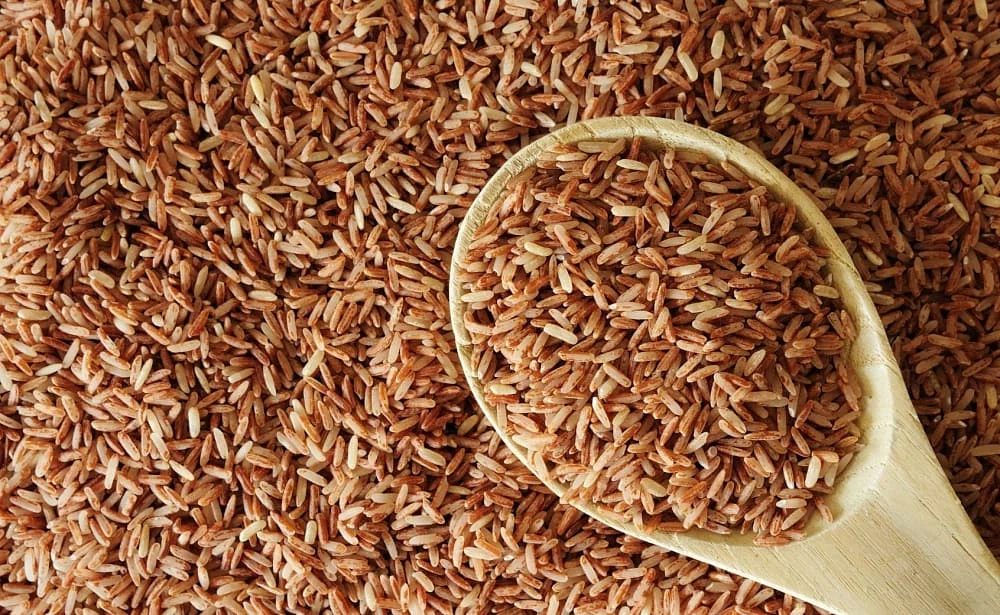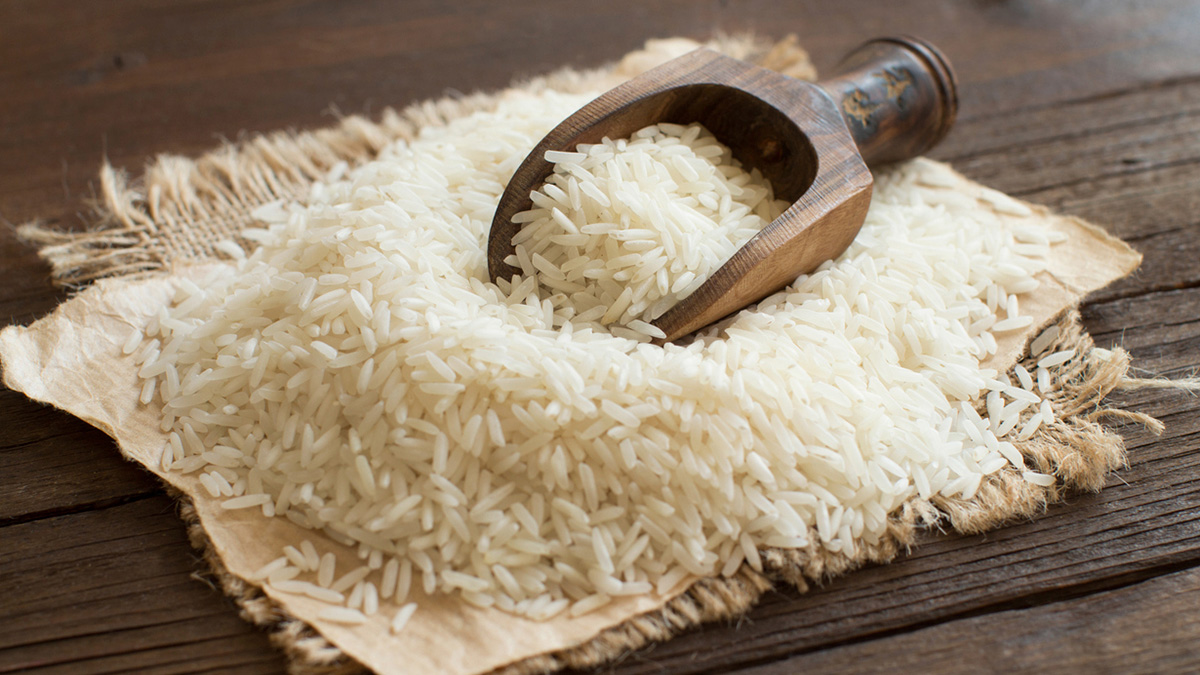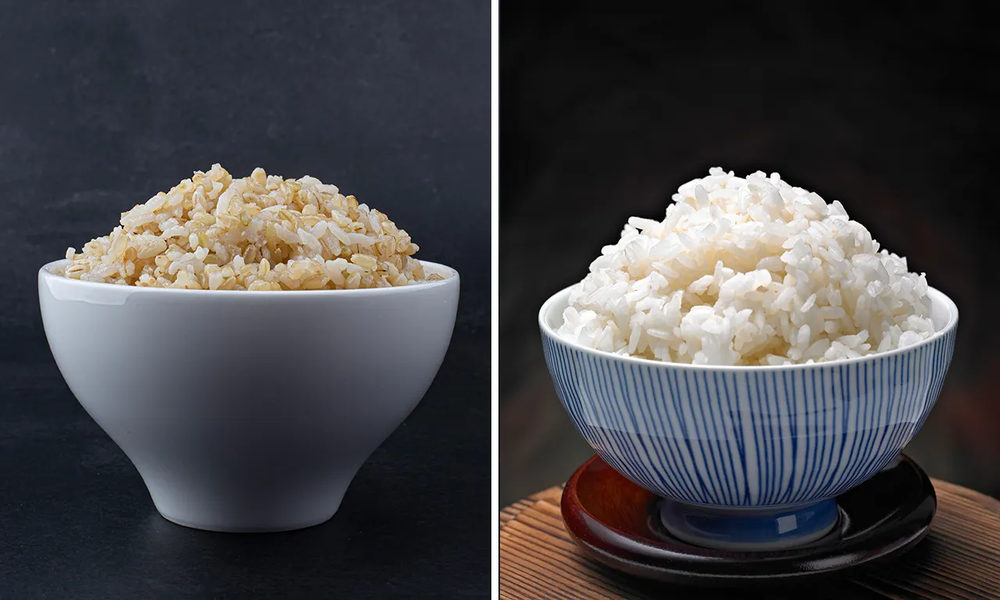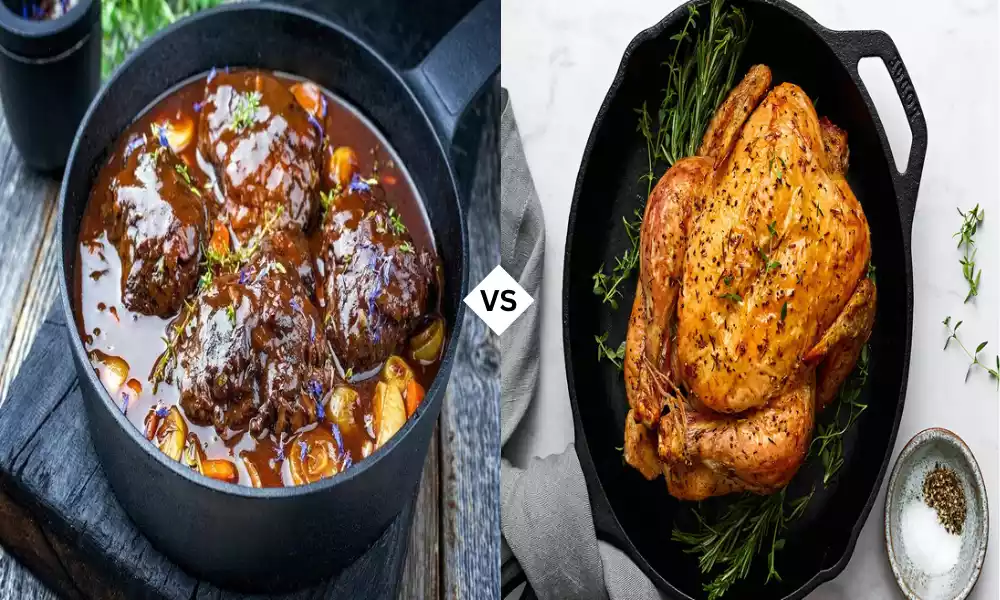Brown rice and white rice are two popular varieties of rice, differing primarily in processing and nutritional content. Brown rice is a whole grain, where only the outer husk is removed, retaining its nutrient-rich bran and germ layers. This gives it a higher fiber content, more vitamins and minerals, and a nuttier flavor compared to white rice.
White rice, on the other hand, is more processed both the bran and germ are removed, leaving mostly the starchy endosperm. This process reduces its natural nutrient content, although many white rice varieties are enriched with added vitamins and minerals.
White rice has a softer texture and a milder flavor, making it a versatile staple in many cuisines. The choice between brown and white rice often comes down to personal preference, dietary needs, and culinary application.
What is Brown Rice?
Brown rice is a whole grain rice with only the outer husk removed, retaining its nutritious bran and germ layers. This minimal processing distinguishes it from white rice, which has both the bran and germ removed, leaving primarily the starchy endosperm.

Brown rice is richer in natural nutrients, including fiber, vitamins (like B vitamins), and minerals (such as magnesium and iron) compared to white rice. It has a more chewy texture, and a sweeter nuttier taste.
Due to its higher fiber content and nutrient density, brown rice is often associated with several health benefits, including better digestion, a lower glycemic index (making it favorable for blood sugar control), and potential protective effects against certain chronic diseases. Brown rice is a staple in many health-conscious diets and is used in a variety of culinary dishes worldwide.
What is White Rice?
White rice is a form of rice that has undergone extensive processing, removing the outer hull, bran, and germ, leaving behind the starchy endosperm. This process results in a grain that is less nutritious than its whole-grain counterpart, brown rice, as the removal of the bran and germ layers strips away significant amounts of fiber, vitamins, and minerals. In many countries, white rice is enriched with vitamins and minerals, such as iron and B vitamins, to compensate for some of these losses.

White rice has a softer, more tender texture and a milder flavor compared to brown rice, making it a versatile ingredient in a wide range of culinary dishes across various cultures. Its ease of cooking and digestibility make it a staple food in many parts of the world.
Additionally, the removal of the bran and germ extends its shelf life, making it a more convenient option for long-term storage. Despite its lower nutritional content, white rice remains a popular choice due to its adaptability to different cooking styles and its central role in many traditional cuisines.
Comparison table of Brown Rice vs White Rice
Here’s a comparison table summarizing the key differences between brown rice and white rice:
| Aspect | Brown Rice | White Rice |
|---|---|---|
| Processing | Only the hull is removed, retaining bran and germ. | Hull, bran, and germ were removed, leaving starchy endosperm. |
| Nutritional Content | Higher in fiber, vitamins (like B vitamins), and minerals (like magnesium and iron). | Lower in fiber and natural nutrients; often enriched with vitamins and minerals. |
| Health Benefits | Aids in digestion, better for blood sugar control, may reduce the risk of chronic diseases. | Easily digestible, but a higher glycemic index can cause quicker blood sugar spikes. |
| Texture and Flavor | Chewier texture and nuttier flavor. | Softer texture and milder flavor. |
| Cooking Time | Longer cooking time and requires more water. | Cooks faster and requires less water. |
| Shelf Life | Shorter due to the presence of oils in the bran and germ. | Longer, as the absence of bran and germ extends shelf life. |
| Use in Cuisine | Often used in health-conscious dishes and whole-grain recipes. | Common in a wide range of dishes, preferred for its versatility and mild flavor. |
This table provides a broad overview of how brown rice and white rice compare across various aspects, including processing, nutritional content, health benefits, and culinary use.
Importance of understanding their key differences
Understanding the key differences between brown and white rice is crucial for several reasons:
- Nutritional Choices: Recognizing their nutritional profiles helps individuals make informed dietary choices. Brown rice offers more fiber, vitamins, and minerals, which are essential for overall health, while white rice provides quick energy with a lower nutrient content.
- Health Considerations: For those managing health conditions like diabetes, heart disease, or digestive issues, choosing the right type of rice can significantly impact blood sugar levels, heart health, and digestive comfort.
- Culinary Applications: Each rice type brings unique textures and flavors to dishes. Knowing these differences allows for better culinary choices, whether you’re aiming for a fluffy bed for a stir-fry or a hearty grain for a salad.
- Dietary Restrictions: For those with dietary restrictions (e.g., gluten intolerance), understanding that all-natural rice is gluten-free is important. However, the glycemic index varies between types, which is crucial for those monitoring their blood sugar levels.
- Weight Management: Understanding the differences can aid in weight management. The high fiber content in brown rice can promote satiety and potentially aid in weight control.
- Cultural and Regional Preferences: Rice is a staple in many cuisines worldwide. Knowing the differences can enhance the appreciation of cultural dishes and regional culinary practices.
This knowledge empowers individuals to make choices that align with their health goals, dietary needs, and culinary preferences, contributing to a well-rounded, health-conscious diet.
Health Benefits of Brown Rice
Brown rice, as a whole grain, offers several health benefits:
- Rich in Nutrients: Brown rice retains its bran and germ, which are rich in vitamins (like B vitamins), minerals (such as magnesium, iron, and zinc), and essential fatty acids.
- High in Fiber: The high fiber content aids in digestion, promoting regular bowel movements and contributing to gut health.
- Blood Sugar Control: Its lower glycemic index compared to white rice makes it a better option for blood sugar regulation, which is particularly beneficial for people with diabetes or those at risk.
- Cardiovascular Health: The fiber, lignans, and magnesium in brown rice may help lower cholesterol and reduce the risk of heart disease.
- Weight Management: The fiber content contributes to a feeling of fullness, potentially aiding in weight management by reducing overall calorie intake.
- Antioxidant Properties: Brown rice contains antioxidants that help combat oxidative stress in the body, potentially reducing the risk of certain chronic diseases.
- Reduced Cancer Risk: Some studies suggest that whole grains like brown rice may be associated with a lower risk of certain types of cancer, particularly due to fiber and essential nutrients.
- Better Metabolic Health: Regular consumption of whole grains like brown rice is linked to a reduced risk of type 2 diabetes and healthier blood pressure levels.
- Gluten-Free: Brown rice is naturally gluten-free, making it a suitable grain option for people with gluten intolerance or celiac disease.
Incorporating brown rice into your diet can contribute to a well-rounded, nutrient-rich eating plan that supports various aspects of health. However, it’s essential to balance brown rice with a variety of other nutritious foods to achieve a comprehensive and healthy diet.
Health Impacts of White Rice
White rice, while a staple food in many diets, has certain health impacts due to its processing and nutritional profile:
- Lower Nutrient Content: Compared to brown rice, white rice has lower levels of fiber, vitamins, and minerals because the nutrient-rich bran and germ are removed during processing.
- High Glycemic Index: White rice has a high glycemic index, meaning it can cause rapid spikes in blood sugar levels. This is a major concern for those suffering from diabetes or susceptible to developing the disease.
- Digestibility: Due to its refined nature, white rice is easy to digest, making it a suitable option for people with digestive issues or those recovering from illness.
- Energy Source: White rice is a quick source of energy due to its high carbohydrate content, which can be beneficial for athletes or highly active individuals.
- Weight Gain: Consuming white rice in large quantities, especially without enough physical activity, can contribute to weight gain and obesity due to its high calorie and carbohydrate content.
- Enrichment: In many countries, white rice is enriched with vitamins and minerals (like iron and B vitamins) to compensate for the loss during processing. This can help prevent deficiencies in these nutrients.
- Lack of Fiber: The low fiber content in white rice means it may not be as effective in promoting satiety or aiding in digestion as whole grains like brown rice.
- Potential Health Risks: Some studies have suggested a link between high consumption of white rice and an increased risk of type 2 diabetes and certain cardiovascular diseases, although more research is required to establish a direct cause-and-effect connection.
While white rice lacks some nutritional benefits, it can still be part of a balanced diet, especially when combined with other nutrient-rich foods like vegetables, lean proteins, and whole grains. Portion control and cooking methods (like pairing with fiber-rich foods) can also help mitigate some of the potential negative health impacts of white rice.
Culinary Uses
Brown and white rice, while similar in origin, are used differently in the culinary world due to their distinct textures, flavors, and cooking properties.
Culinary Uses of Brown Rice:
- Whole Grain Dishes: Brown rice is often used in recipes that call for whole grains, offering a nutty flavor and chewy texture.
- Health-Conscious Cooking: It’s a popular choice in health-focused meals due to its nutritional profile, including in salads, Buddha bowls, and vegetarian dishes.
- Stir-Fries and Pilafs: Its chewy texture holds up well in stir-fries and pilafs, providing a hearty and satisfying base.
- Casseroles and Stuffed Vegetables: Brown rice adds a robust texture to casseroles and works well as a filling for stuffed peppers or tomatoes.
- Rice Pudding and Porridge: When cooked slowly, it makes for a rich and creamy rice pudding or porridge, albeit with a distinct texture compared to white rice.
Culinary Uses of White Rice:
- Staple in Many Cuisines: White rice is a fundamental component in various global cuisines, including Asian, Latin American, and Caribbean dishes.
- Sushi and Onigiri: Its sticky and tender texture makes it ideal for sushi and Japanese onigiri (rice balls).
- Side Dishes: White rice is commonly served as a neutral, fluffy side dish to accompany curries, stews, and grilled meats.
- Risotto and Paella: Its ability to absorb flavors and creamy consistency when cooked makes it perfect for dishes like Italian risotto and Spanish paella.
- Desserts: White rice is used in sweet dishes like rice pudding, where its soft texture blends well with milk and sugar.
Both brown and white rice are versatile and can be adapted to a wide range of recipes. The choice between them often depends on dietary preferences, desired nutritional value, and the specific requirements of the dish being prepared. Brown rice brings a hearty, nutty quality to dishes, while white rice offers a soft, subtle backdrop that pairs well with a variety of flavors and ingredients.
Cooking Tips for Both Rice Types
Cooking brown and white rice requires different techniques due to their distinct textures and nutritional properties. Here are some tips for each:
Cooking Tips for Brown Rice:
- Rinse Before Cooking: Rinse brown rice under cold water to remove any dust or impurities.
- Longer Cooking Time: Brown rice takes longer to cook than white rice due to its outer bran layer. Expect a cooking time of about 45 minutes.
- More Water: Use more water compared to white rice. A general ratio is 2 1/2 cups of water for every 1 cup of brown rice.
- Soaking: Soaking brown rice for a few hours before cooking can reduce cooking time and make the rice less chewy.
- Simmer and Steam: Bring the water to a boil, add the rice, then reduce to a simmer. Cover the pan and allow it to simmer until the water has been completely absorbed. Turn off the heat and let it steam with the lid on for 5-10 minutes.
- Fluff with a Fork: After cooking, you can make sure to fluff the rice using a fork to make sure the grains are separated.
Cooking Tips for White Rice:
- Rinse the Rice: Rinse white rice until the water runs clear to remove excess starch, which can make it sticky.
- Water Ratio: Use a 2:1 water-to-rice ratio for cooking white rice.
- Boil and Simmer: Bring water to a boil, add rice, stir once, then reduce heat to a low simmer and cover the pot.
- Avoid Stirring: Don’t stir the rice while it’s cooking as this can release starches and make it sticky.
- Cooking Time: White rice usually cooks in about 18-20 minutes. Check the package for specific types as cooking times can vary.
- Let it Sit: After cooking, remove it from heat and let it sit, covered, for about 5 minutes. This allows rice to absorb the remaining water and soften to the touch.
- Fluff and Serve: Fry with a fork before serving to make sure the grains are separated.
Remember, altitude, the type of pot used, and even the age of the rice can affect cooking times, so adjustments may be necessary. Additionally, consider using a rice cooker, which can simplify the process and yield consistent results for both brown and white rice.
Final Thoughts
Brown Rice vs White Rice offers distinct nutritional and culinary profiles. Brown rice, a whole grain, is richer in fiber, vitamins, and minerals, benefiting digestion and overall health, but requires longer cooking time.
White rice, being more processed, offers a softer texture and quicker cooking convenience, but with less nutritional value. The choice between them depends on health goals, dietary preferences, and culinary needs.































